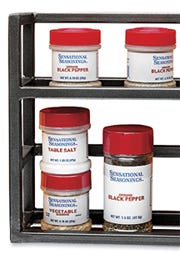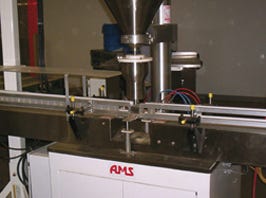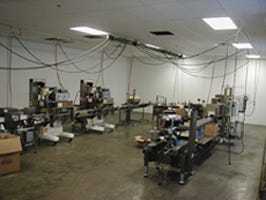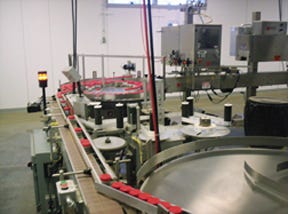Spice-bottling line packs pride, patriotism, personal growth
March 11, 2015

Located in the greater Rochester, NY area, human-services provider Continuing Developmental Services (CDS) grew from a group of parents who wanted better services for their children with developmental disabilities. This year, CDS celebrates 30 years of operation since its incorporation in 1977. The human-services organization now has programs for more than 1,700 people with developmental disabilities. CDS divides the services workload by dedicating each of its business units to one of four specific services: residential, employment, day or family support. CDS-Unistel is the organization's employment division, and one of Unistel's support offerings is on-the-job training at its spice-packaging facility.
Packaging appealed to the organization because disabled individuals can have above-average skills for typical tasks on a packaging line. “People are far more abled than they are disabled,” explains Unistel vp and general manager Morris Lew. “So, we don't focus on their disabilities; we focus on what they are good at. For example, autistic people love repetition. Something that might bore an average person to death, they like to do. We have a lot of people who stare at one machine for eight hours a day at a time. And, they enjoy what they do.”
Like many for-profit packaging operations, CDS-Unistel started manufacturing with simple production lines. Originally, the organization only packed granulated garlic using semi-automatic auger fillers from AMS Filling Systems, Inc. (www.amsfilling.com). “The original lines were not so much lines, they were just filler machines,” recalls AMS sales engineer Scott Tiffany. “They were placing the containers by hand, initiating the fills and sealing the bottles manually.”

The auger filler can dispense powders, granules, creams and liquids, and it can achieve line speeds exceeding 100 containers/min.
The machines also were very safe to use, which was important because the Unistel staff did not have experienced packaging experts to teach the employees.” Most of the people here are human-services people—not manufacturing people,” says Lew.
As human-services professionals, the Unistel folks are trained to recognize fund-raising potential, and there is fund-raising potential in spice packaging. To pursue that business, Unistel had to build a more automated line. While the organization lacked internal packaging experts, it did have a strong relationship with at least one packaging-equipment manufacturer: AMS Filling. “They've been a customer with us since October 1994,” recalls Tiffany.
It was through this relationship that Lew met Steve Friedman of Rypac Packaging Machinery, Inc. (www.rypac.com), a manufacturer's representative with 34 years of experience in packaging-machinery automation. Friedman was intrigued when Lew told him about the charge from his parent organization: Put together an automatic packaging line to replicate what food-manufacturing companies do, creating jobs for the people who run the line and, in some cases, training them for employment outside of Unistel.
Before the organization could partner with Friedman, Unistel had an obligation to the disabled people it serves and its packaging-operation customers to discover what other manufacturers representatives and systems integrators had to offer. “We originally worked with more than one integrator and told them what we needed to accomplish,” Lew explains. “We evaluated multiple suggestions, and we went to multiple facilities before settling on Friedman.”
The new line uses standard packaging equipment, some of which the manufacturers customized for special-needs operators. Using industry-standard equipment helps Unistel prepare some of its most capable operators to learn skills applicable to the commercial-packaging marketplace. “We wanted to have part of our organization look like a typical factory,” recalls Lew. “Packaging is a very typical, for-profit, commercial venture.”
The automated packaging line has 13 major pieces of equipment: a KAPS-ALL Packaging Systems, Inc. (www.kapsall.com) Model AU-6 bottle unscrambler; an AMS A-400 filler; an Anritsu Industiral Solutions USA, Inc., (www.us.anritsu-industry.com) Model KW6201BF04 checkweigher; a Fortress Technology, Inc. (www.fortesstechnology.com) Phantom metal-detection system; a Kaps-All BE4 overcapper; a KAPS-ALL A6 screw capper; an AutoMate Technologies (www.automatech.com) Model AM-250 foil-induction sealer and inspection station; two KAPS-ALL FS-S surge tables; a Labeling Systems, Inc. (www.labelingsystems.com) Model 1500 automatic-wrap labeler; a Model EZ 100 tamper-evident neck-banding machine from the Axon Div. of Pro Mach (www.axoncorp.com) a Wrabacon, Inc. (www.wrabacon.com) pack table; and a Chicago Tapers (www.chicagotapers.com) Model CT 32 semi-automatic top-and-bottom case-taping machine.
The KAPS-ALL bottle unscrambler takes bottles from the bulk-supply hopper, separates them, orients them neck-side-up and sends them to the filler on a conveyor in single-file orientation. The AU-6 model is a fully automatic machine with electronic, variable-speed controls for orienting functions and enclosed stainless-steel and polycarbonate safety guards. It operates at speeds in excess of 300 bottles/min.
The bottles are side-transferred onto the AMS A-400 filler from one conveyor to another. According to Friedman, side-transferring the bottles is a smoother way to move the bottles from one machine conveyor to another. A standard A-400 machine can dispense powders, granules, creams and liquids and it can achieve line speeds upwards of 100 containers/min. Its fill height can be adjusted using the mechanical column-jack assembly.
AMS did customize the bulk feeder for easier use by Unistel's disabled operators. “We gave our control box an umbilical cord,” remarks tiffany. The umbilical cord allows a wheelchair-bound operator to adjust the control box to his or her level, while a standing operator can adjust the controls back up to full height.
On Unistel's line, the auger filler queues one bottle at a time into the filling station, where it receives a metered amount of spices. The A-400 uses an auger that rotates a programmed number of times to deliver the correct amount into each bottle. Bottles exit the filler via a specially designed end transfer, which keeps the newly filled bottles from spilling over as they enter the Anritsu checkweigher.
The bottles then are weighed while kept in motion. Explaining how the checkweigher performs the dynamic weighing, Anritsu Industrial Solutions USA field sales manager Rob Tiernay states: “Our system usually has three belts, a short infeed conveyor and a weighing platform. With the three-belt system, the package enters on the infeed system where we can weigh in motion and weigh very fast and while it's moving. But, we can weigh only one at a time.”
The KW6201BF04 model used at Unistel rejects any under- and overweight bottles. The checkweigher's software, also known as checkware, automatically evaluates sample groups of 10 or 20 bottles and detects any trends up or down in weight. This trend control can make the machine easier for disabled operators to use. “When you don't have trend control, someone has to remove the packages and check them on a static weigher,” says Tiernay. “The trend control takes the human interface out of the equation. It will display a histogram that will identify good weighs, underweighs and overweighs. The checkware then automatically sends a signal to the filler to adjust the weights.” Unistel's checkweigher controls also are positioned low enough to be accessible for wheelchair-bound operators.
The Fortress Technology Phantom metal-detection system then automatically rejects bottles that test positive for rogue metal pieces. All other bottles are sent to the capping conveyer, where sifters and screw caps are applied.
A Kaps-All BE4 overcapper takes sifters from a bulk supply, separates them and brings them to a placement station, where a sifter and its foil liner are pressed onto the bottleneck.
Like the company's overcapper, the Kaps-All A6 screw capper takes caps from a bulk supply, separates them and brings them to a placement station. The A6 then rotates the cap to tighten it onto the bottle. A standard A6 model is a fully automatic capper that works with screw caps from 8 mm to 120 mm, including pilfer-evident and child-resistant cap closures. Depending on the cap and container sizes, the A6 can operate at speeds up to 200 bottles/min.
Unistel's spice bottles then are moved to an Automate AM-250 foil induction sealer and inspection station, where they are checked using a series of sensors. Bottles with missing caps or foil seals and bottles with high or cocked caps are rejected from the packaging line. A high-frequency sealer then heat-seals the liner onto the rim of the bottle.

Wheelchair accessability is essential on this line, so power is supplied to all of the machines from overhead, rather than through conduits on the floor.
The sealed and capped bottles are transferred onto a Kaps-All FS-S surge table before traveling through the Labeling Systems, Inc. (LSI) 1500 automatic wrap labeler. The 1500 grabs a bottle off the conveyor, peels a label off a roll, then spins the bottle to apply the label. While the 1500 is one of the standard machines that LSI offers, the machine installed at Unistel had its controls modified to be handicap-accessible. After labeling, the bottles travel to another FS-S surge table.
The bottles then move to an Axon EZ 100, which applies a tamper-evident neckband. The EZ 100 cuts a piece of circular band from a roll and uses small, side, hot-air blowers to fix the band in place before moving the bottle down a heat tunnel. The heat tunnel shrinks the bands, which form tight seals over the bottles. Axon Corp. modified the controls on Unistel's machine to be easily accessible to wheelchair-bound individuals.
After the bottles exit the heat tunnel, they are moved to a Wrabacon over/under packing table. The Wrabacon table has two stacked conveyors in addition to a working surface that allows operators to manually erect shipping cases. Bottles arrive on the top conveyor, then are placed manually into an erected case. Once a case is packed, an operator uses the lower transfer conveyor to move the cases into the Chicago Tapers CT 32 semi-automatic taper.
When the CT 32 receives the case, it applies tape to the bottom and top flaps simultaneously. According to Chicago Tapers sales associate Carol Gaitors, the semi-automatic device is a good choice for packaging operations with disabled operators because it doesn't have as many moving parts as fully automatic tapers.
Lew hopes his organization's project will encourage other packaging operations to hire disabled operators. Specifically, he would like Unistel's automated line to serve as a working demonstration of a handicapped-accessible line that is neither expensive nor difficult to buy. “Modifying the equipment was easy and didn't cost very much,” Lew comments. “For example, Kaps-All added elevators for us, which are standard options for their machines. We choose those options so someone can load the capper on lower, and the hopper elevates the capper.”
To design the line, Friedman first had to identify how a disabled operator, specifically a wheelchair-bound person, could man most stations in the line. “The controls and access had to be designed so that people in wheelchairs can reach them,” said Friedman. “So, we sat down and pretended where a wheelchair would be on the line. That was an engineering challenge.”
Wheelchair accessibility was so important that Unistel stripped a warehouse space down to the floor before any equipment was installed. Instead of supplying power to the machinery through conduit pipe on the floor, the organization had all power lines run overhead. “Because of the wheelchairs, the floor had to be clear,” Friedman explains. “There are no cables for the wheelchairs to run over.”

The controls on the labeler have been modified to be handicap accessible.
Friedman identified the manufacturers most willing and able to modify standard models. He then worked closely with those manufacturers to keep costs down while achieving Unistel's accessibility goals. “It was a very closely managed relationship between Steve and ourselves to make sure all the specific requirements were met,” Axon Corp. sales vp George Albrecht recalls. For many of these companies, customization is a standard part of the purchasing process. Labeling Systems' executive vp Jack Roe explains, “While the series 1500 is a standard machine from us, most of the units are modified for customers.”
Unistel offers job placement services at no cost to an employer. The organization's job developers match each operator's abilities and interests to a specific job.
The new packaging line offers Unistel the ability to provide real work experience for its operators. “Part of what the organization does is grow the person,” Lew explains.
“From the employment standpoint, they gain experience with general machine operation and handling,” AMS company spokesperson and CFO Andy Baker explains. “The customer can get acclimated to the PLC controls commonly used for the automation of various industrial processes. The programming and control design allows the operators to address minor maintenance issues.”
In addition to access to Unistel's trained workforce, some participating employers also can qualify for a work opportunity tax credit up to $2,400 per disabled operator.
If a company wants to use the organization's trained operators without bringing them on location, it can have products copacked at Unistel's facilities. “We're always looking for new people to copack for,” Lew remarks. Spice distributors can take advantage of the organization's quality assurance laboratory and supplier relationships. Lew explains, “We're able to buy in large quantities at competitive prices because of our affiliation with the military.”
Unistel packs the spices used in the U.S. military's food service program. “Our spices are sold all around the world,” says Lew. “There are dining halls in Iraq using our spices; the dining halls at Fort Drum use our spices. The military is our number-one customer.”
In addition to its initial offering of granulated garlic, Unistel now packs an array of spices for the armed forces. “For the military, we offer 12 and about to offer four more spices,” Lew explains. “Overall, we offer 199.” Unistel's spice line includes anise, basil, bay leaves, cajun spice, caraway, celery salt, chili powder, cinnamon, cloves, coriander, cumin, curry powder, ginger, marjoram, mustard, onion, paprika, black pepper, rosemary, sage and thyme.
Unistel's work for the military is an additional source of pride for its disabled operators. “They have pride in their work, and they're particularly proud of helping our troops,” Lew remarks.
The manufacturers that customized equipment for Unistel helped make that contribution possible, and many of them are grateful for the opportunity. “I have a handicapped child myself,” Albrecht remarks. “It was wonderful working with this organization, knowing they are helping people take a step above. It's not that often you see this side [of the business]: The human side of packaging.”
More information is available: |
AMS Filling Systems, Inc., 800-647-5390.www.amsfilling.com. |
Anritsu Industrial Solutions USA, Inc., 847/419-9729,www.us.anritsu-industry.com. |
AutoMate Technologies LLC, 631/727-8886.www.automatetech.com. |
Axon, a division of Pro Mach, 800/598-8601.www.axoncorp.com. |
Chicago Tapers, 800/700-5677.www.chicagotapers.com. |
Fortress Technology, Inc., 888-220-8737.www.fortresstechnology.com. |
KAPS-ALL Packaging Systems, Inc., 631/727-0300.www.kapsall.com. |
Labeling Systems, Inc., 201/405-0767.www.labelingsystems.com. |
Rypac Packaging Machinery, Inc., 800/237-8722.www.rypac.com. |
Wrabacon, Inc., 207/465-2068.www.wrabacon.com. |
About the Author(s)
You May Also Like


